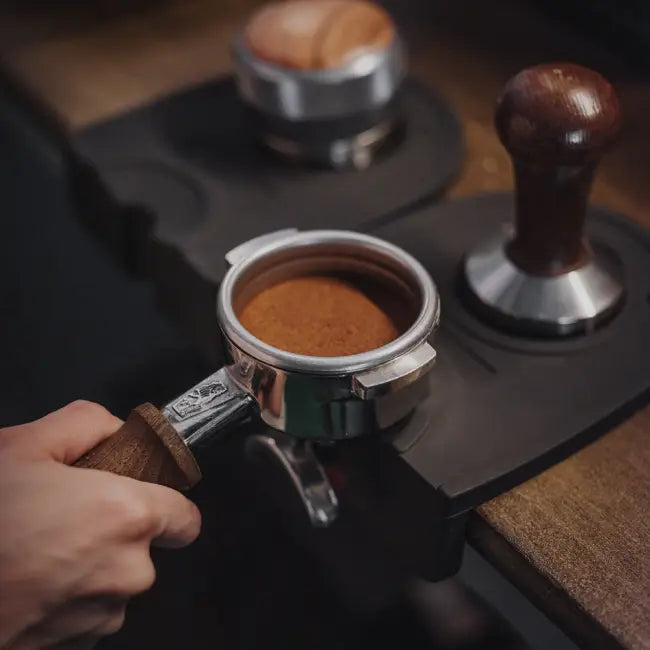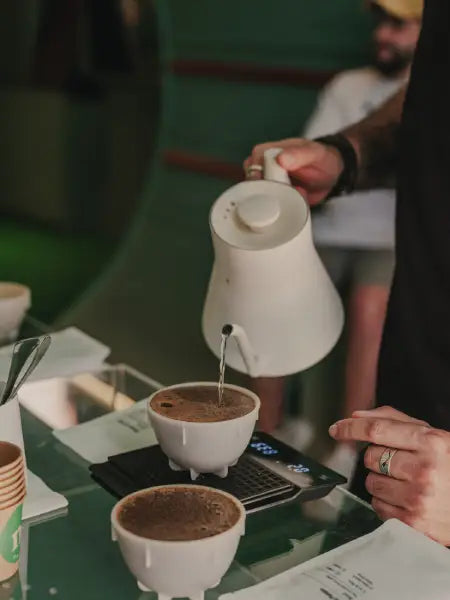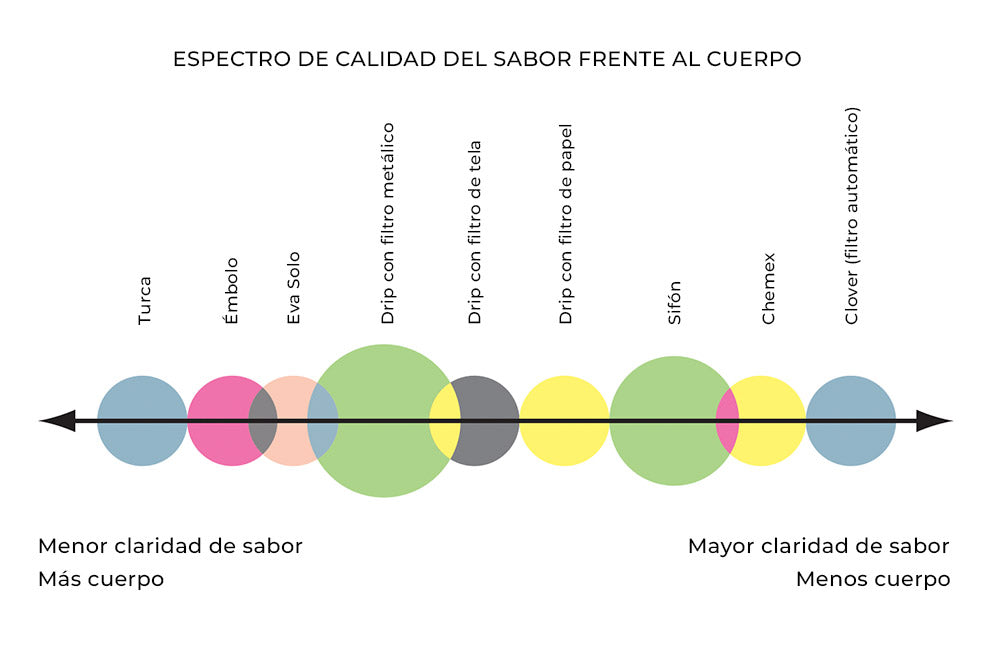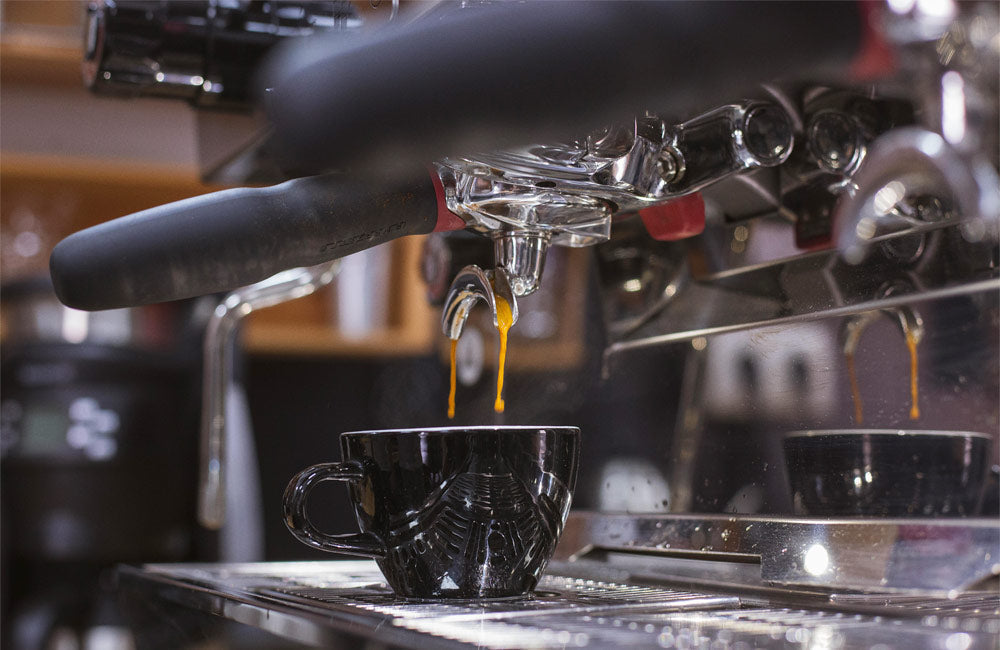Ground coffee
Marco Polo is one of the most famous travelers and merchants, even though his journeys took place in the 13th century. During his many travels, which took him throughout Asia, especially present-day Mongolia and China, Marco Polo was always involved in trade.
He traveled along the Silk Road, and one of the most prized goods moving along this route was spices: pepper from India, cinnamon from Ceylon, and ginger from China. Spices and coffee share a common history: that of this intercontinental trade.
But there's something else: if you grind them before using them, they lose their properties. That's why ground coffee wasn't suitable for transporting from one place to another then, but it isn't now either. And that's what this post is about: why it's better to keep coffee beans until you're ready to use them and how to grind them.
What are we talking about when we talk about ground coffee?

Sprout of a coffee plant
It may seem like a redundant question, but it isn't. Coffee is the seed of the berry of the coffee plant.
That is, it's a seed in the form of a grain like many others. But when ground and extracted with water, we obtain a beverage with very specific organoleptic qualities and properties.
All stages of the coffee process are important .
The coffee grower who chooses a particular piece of land and location to plant, the type of coffee plant chosen, the way it is grown and harvested, the method of drying, transporting, roasting and packaging, all leave a mark on the coffee seeds until they reach the coffee shop or our home.
Throughout this entire process, the coffee has been (or should have been) kept in its bean form to maximize its organoleptic qualities. But once it's ready to be brewed, the coffee must be ground. How we grind it, with what tools, to what size, and when, is a very important part of this entire process, but one that many people don't pay enough attention to.
When we talk about ground coffee, we're referring to the importance of preserving coffee beans until the very last moment, and why , what tools to use when grinding, what grind size to use, how to store and prepare it. All of this is to ensure we do justice to the work of so many people until it reaches us and, above all, that we enjoy every cup of coffee to the fullest.
Why is it important to keep coffee beans in their original state until use?

Ripe fruit due to oxidation
Because of oxidation . This is the main reason why we should grind coffee just before using it. And you might be wondering, but does coffee oxidize? Yes , it does. In fact, every organic compound oxidizes when it comes into contact with oxygen. This is why coffee ripens, changes color, and rots.
Oxidation, at the molecular level, occurs because oxygen molecules steal electrons from other molecules, and the molecules that lose them become unstable and reactive. This changes the molecular composition of the organic compound—in this case, coffee—and, therefore, its organoleptic properties as well .
Coffee beans contain oils, chemicals, and acids that dissolve when they come into contact with water. These soluble elements are what give this beverage its distinctive color, flavor, and aroma . If these elements degrade before extraction, the resulting beverage will be of lower quality. That is, it will lose some of its organoleptic qualities.
These qualities are determined by factors as diverse as the place of origin, altitude, climate, type of plant, drying and washing, and roasting. At each stage, everyone involved has ensured that every process highlights the unique qualities of each bean. If we grind the coffee too far before consumption, we will have the opposite effect ; we will be harming these qualities.
This is because when we grind coffee, we expand the surface area of contact between oxygen and the coffee molecules , thus accelerating the oxidation process. While ground coffee is essential for proper extraction, since this is how the solubles dissolve, the best time to grind it is just before extraction.
Extraction theory

Ground coffee bed for preparing a V60
Once we've established that coffee should be kept in its original state until it's ready for brewing, and before moving on to how we grind it, what tools we use, and how we store it, we'll discuss two important theoretical topics: extraction theory and grind size and distribution.
Extraction theory refers to how we extract the solubles from the coffee when they come into contact with water, and how much of the solubles remain dissolved once we're done. As Ted Lingle says in The Coffee Brewing Handbook :
“ Extraction is a measure of the amount of solubles in the final beverage . It is also expressed as a percentage, comparing the amount of coffee solids in the beverage with the amount of ground coffee used to prepare it. Approximately 28% of the organic and inorganic matter contained in roasted coffee beans will readily dissolve in water. The remaining 72% is the cellulose fiber from the seed, which is not soluble in water under normal brewing conditions.”
Although only 28% of the coffee that might be dissolved in the water when we prepare the drink is made up of approximately 800-1000 natural flavorings and aromas , half of them soluble solids and the other half gaseous and/or volatile aromas. These compounds are what give each cup of coffee such complexity.
When we talk about extraction theory, we are referring to extraction percentages , which are related to the method we use to perform the extraction - filter, espresso, immersion - in relation to the amount of solubles dissolved in the final beverage.
This is important because, depending on the method, we will need a different grind size to achieve the desired extraction percentages.
TDS measurement

Measuring solubles in coffee with a TDS detector
The second part of this theory concerns total dissolved solids (TDS). TDS is a measure that helps us determine the percentage of solids in a cup of coffee . That is, out of a 200 ml cup of coffee, what percentage is water and what percentage is coffee (or other solids found in the water).
So, on the one hand, we have the percentage of potential solubles that can be extracted from the coffee (the maximum being 28% of each bean) and on the other, we have the total percentage of dissolved solids in each cup of coffee, which vary depending on the method used and the desired beverage and the technique and precision of the barista.
The percentage of solubles dissolved in coffee that professionals have discussed and experimented with so far is between 18% and 22% of the total possible (28%).
Although this is changing. Recently, with new advances, better roasted coffees, and more controlled extraction methods, these percentages are increasing above 22% with very positive results. We could say that the cutting-edge of coffee now ranges from 18% to 27%, with excellent results.
These would be appropriate percentages depending on the method:
- Filtered: 1.2% - 1.6% (TDS)
- Americano, long black: 2% - 5% (TDS) (depends on the amount of water added)
- Lungo: 5% - 7% (not a common drink) (TDS)
- Espresso: 7% - 10% (TDS)
- Ristretto: 10% - 12% (TDS)
For a cup of origin coffee to be balanced and for us to notice all the organoleptic qualities, between 18% and 22% of all solubles must have dissolved, and this must represent a percentage between 1.2% and 12% of the total solids in each cup.
If these percentages are above or below average, the cup may be under-extracted or over-extracted. Both results are not advisable, since the former will not fully capture the coffee's aromas and flavors, and the latter will be over-extracted, and the bitterness and other undesirable notes will mask the desirable tasting notes.
Enjoy seasonal coffee, visit our store
Grind size
 Grinding in a professional grinder
Grinding in a professional grinder
And we might ask ourselves, what does all this have to do with ground coffee and the type of grind? Well, among the parameters we must control to obtain a proper cup of coffee, once we have roasted the coffee, two of the most important may be the grind size and the water/coffee ratio.
To obtain a correct extraction, and we have already defined what we mean by this, one of the most important elements is that the coffee grind size is in accordance with the method we are going to use so that an extraction is achieved within the percentages we have mentioned.
Let's say there are three general ways to do extraction: immersion (French press) , percolate/filter (AeroPress, V60, Kalita, etc.), and espresso .
Depending on the brewing method (immersion, percolate/filter, or espresso) and the technique (AeroPres, V60, espresso), we'll use one grind or another. Here's a general guide:
- Espresso: very fine grind (almost like flour)
- Mokka: fine grinding (like fine salt)
- Aeropress: medium grind (slightly coarser than fine salt)
- V60: medium grind (slightly coarser than fine salt)
- Chemex: medium grind (slightly coarser than fine salt)
- Plunger: coarse grinding (like coarse salt)
And we'll just briefly mention the coffee-to-water ratio: most immersion and percolate/filter brewing ratios are between 1:10 and 1:18 . The notable exception is espresso, which is between 1:1 and 1:3 because the extraction is faster and more efficient.
This ratio means that for every gram of coffee we would use between 10 and 18 grams of water for immersion and percolation/filter, and with espresso, for every gram of coffee we would obtain between 1 and 3 grams of beverage in the cup.
Equip yourself with our accessories, visit our store
Grinding distribution
 Professional coffee grinder from the Mahlkonig brand
Professional coffee grinder from the Mahlkonig brand
Finally, we need to talk about the particle distribution in the grind. When we grind coffee, not all ground particles are the same size . Within a certain range, some particles will be very fine and others very coarse.
The unit we use to measure coffee particles is microns. When grinding coffee, a grinder will give us particles of many different sizes: from particles of one micron to those of 1,500 microns, although we will generally divide them into those below 100 microns, those with a size of about 400 microns, and those with a size of about 800.
This is important because when extracting , we are looking for the ground coffee to be as homogeneous as possible , that is, for all the particles to be within a small range.
If this is not the case, if there are particles that are very uneven in size, the extraction will not be uniform and the result may be an over-extracted and under-extracted cup at the same time (the large particles have not dissolved all the solids they should and the small ones have dissolved more than they should).
Summary of grinding theory
 Different preparation methods require different grinds
Different preparation methods require different grinds
To simplify this theory a little and make it more practical, we can establish the following parameters (at the cost of losing a bit of accuracy):
A finer grind results in a slower water flow, which results in a longer contact time between water and coffee and, therefore, greater extraction.
On the contrary:
A coarser grind results in a faster water flow rate, which results in a shorter contact time between water and coffee and, therefore, a lower extraction rate.
AND:
For infusion methods we will use a coarse grind, for percolate/filter methods we will use a finer grind, and very fine for espresso.
How to grind coffee
Now that we are aware of the importance of preserving the coffee beans and grinding them correctly , how do we grind the coffee?
The answer is simple, but there are several possibilities. Obviously, we'll need a grinder if we want to make it at home. Coffee grinders come in both manual and electric versions.
We recommend using manual grinders at home (unless you want and can spend several hundred euros on a professional electric coffee grinder). This is because commercial electric grinders with blades don't grind the coffee, but rather grind it and also heat it (due to the friction of the blades and the motor). Most low-end electric grinders will give us a very wide grind distribution range, which is not recommended.
 Manual coffee grinders from the Comandante and Timemore brands
Manual coffee grinders from the Comandante and Timemore brands
Manual coffee grinders typically have conical ceramic burrs, which grind the coffee and then it falls into a separate compartment, which helps achieve a more even grind.
In our store, you can find several models at different prices. The Comandante manual coffee grinder is one of our most recommended. And this HARIO Mini Mill grinder is also great if you're on a budget.
Finally, if you don't have a grinder yet, you can buy coffee beans and have them ground at your local coffee shop. This isn't our recommended method, but if you store them well and consume them within a short period of time, they shouldn't lose too many of their properties.
How to store ground coffee
We always recommend storing coffee beans until just before use , but we understand that there may be situations where this isn't possible. Therefore, we're going to provide some recommendations on how to store ground coffee.
If you're buying coffee and don't have a grinder, ask for it to be ground according to the brewing method and technique you'll be using. Ask for it to be packaged in a resealable bag with a one-way valve (quality bags used to package coffee beans usually do this). Once home, store it away from sunlight and strong odors in an airtight container. Finally, consume it quickly, as, as we've discussed, it will gradually lose its properties with each passing day.
By following these simple instructions, you can continue enjoying coffee, even if it has been ground for a while.
How to prepare ground coffee

Preparing coffee with the Kalita technique
Ground coffee can be prepared using three different methods: immersion, percolate/filter, and espresso.
Each method has a series of techniques. The most well-known immersion method is the French press , but other methods include the AeroPress , the siphon, the Clever, and cupping preparations. Filter methods include the V60, the Chemex, and the Kalita, as well as electric drip coffee makers like the Behmor Brazen coffee maker. The espresso method is essentially achieved with an espresso machine.
Regardless of the method and technique, the main idea is the same: the water must be in contact with the ground coffee for a specific amount of time and in a specific ratio (we have talked about both of these things before).
How to make ground coffee without a coffee maker
And you might be wondering , "Can you make ground coffee without a coffee maker?" Yes, you can, although you have to be much more careful to get it right.
A very common way to do it, and one we recommend for summer , is Cold Brew . You won't need a coffee maker for this, but you will need a container and cheesecloth. If you're interested, we explain how to do it step by step in this post .
Another way is to make it the old-fashioned way, using a pot of coffee , and although a bit rudimentary, it can get us out of a tight spot. It's quite simple and resembles an immersion method. We need coarsely ground coffee and a quantity of water that gives us a ratio of about 15 grams of water per gram of coffee. Aside from this, we also need a pot and a strainer (if we have one).
To do this, bring the water to a boil, turn off the heat, and wait about two minutes. Then add the coffee and stir gently. Wait about four minutes and pour it through a strainer or decant it. You can enjoy a decent cup of coffee without a coffee maker.
What is the best ground coffee and where to buy it?

Preparation with the V60 technique
The best ground coffee will always be the best whole bean coffee . And the best whole bean coffee is the one processed from the brewery with care and following the guidelines of what we understand as specialty coffee .
This means that the coffee must be fresh, seasonal, and recently roasted . If we want coffee in optimal condition, we should consume it within twelve weeks of roasting, if it has been stored properly.
The type of roast, whether a lighter or darker roast, will depend on our tastes and preferences. But we should never buy coffee that's overly roasted or burnt, as this will result in the loss of organoleptic qualities.
You can buy ground and whole bean coffee in our store or visit your favorite specialty coffee shop.
Ground coffee vs. whole bean coffee
Should you buy ground coffee or whole beans? We hope this post has answered this question: it's always advisable to buy whole beans and grind them before use to avoid oxidation and degradation of their organoleptic properties.
We've discussed the theory of extraction and the size and distribution of ground coffee particles. In this regard, to achieve extraction percentages (between 18% and 22%) and TDS (between 1.2% and 12% depending on the method), the grind must be tailored to the desired extraction and as homogeneous as possible. For this, the water/coffee ratio is also important.
For a proper grind, we recommend using a manual coffee grinder at home. And only in situations where you have no other option, buy whole beans and have them ground.
In all cases, but especially if the coffee is ground, preservation is very important . We must ensure that it is in airtight bags with a one-way valve.
And when it comes to preparing it, the grind size will depend on the method you're using . But generally speaking: a coarse grind for immersion methods, fine for percolate/filter, and very fine for espresso.
All this so that we can enjoy our coffee to the fullest and do justice to the work of all those who have worked hard to ensure that each coffee bean reaches us in optimal condition.
Now that you know all this… all you have to do is choose which coffee you'd like to try.









